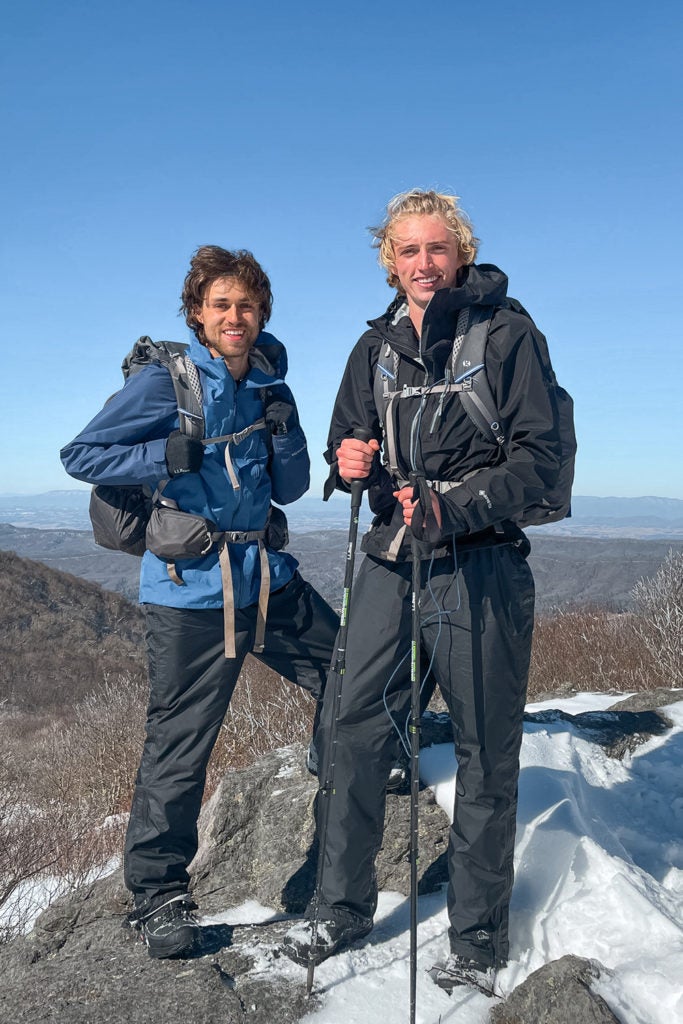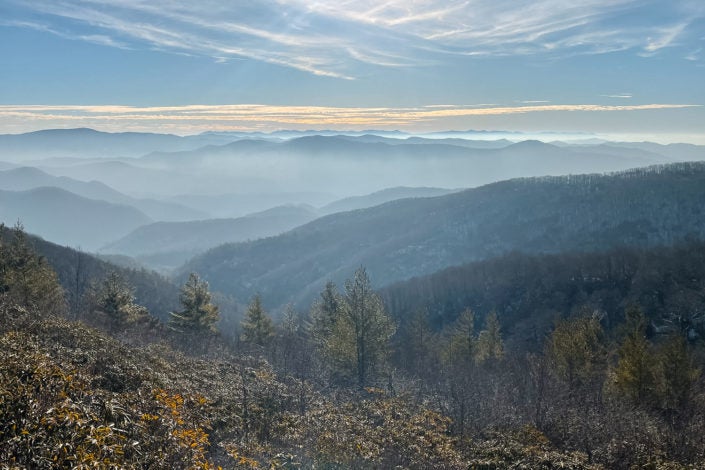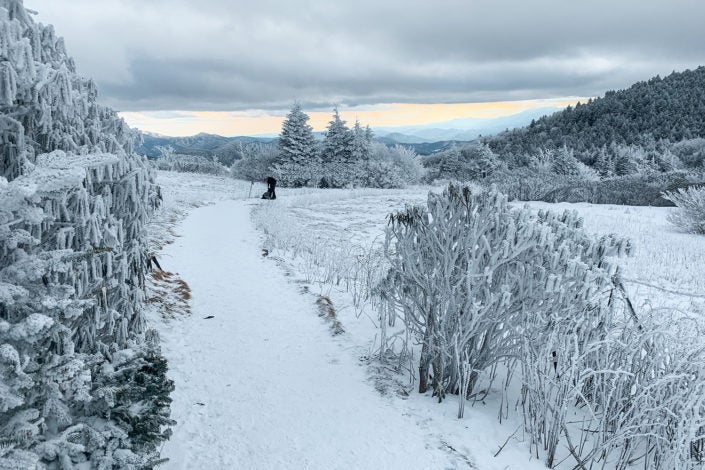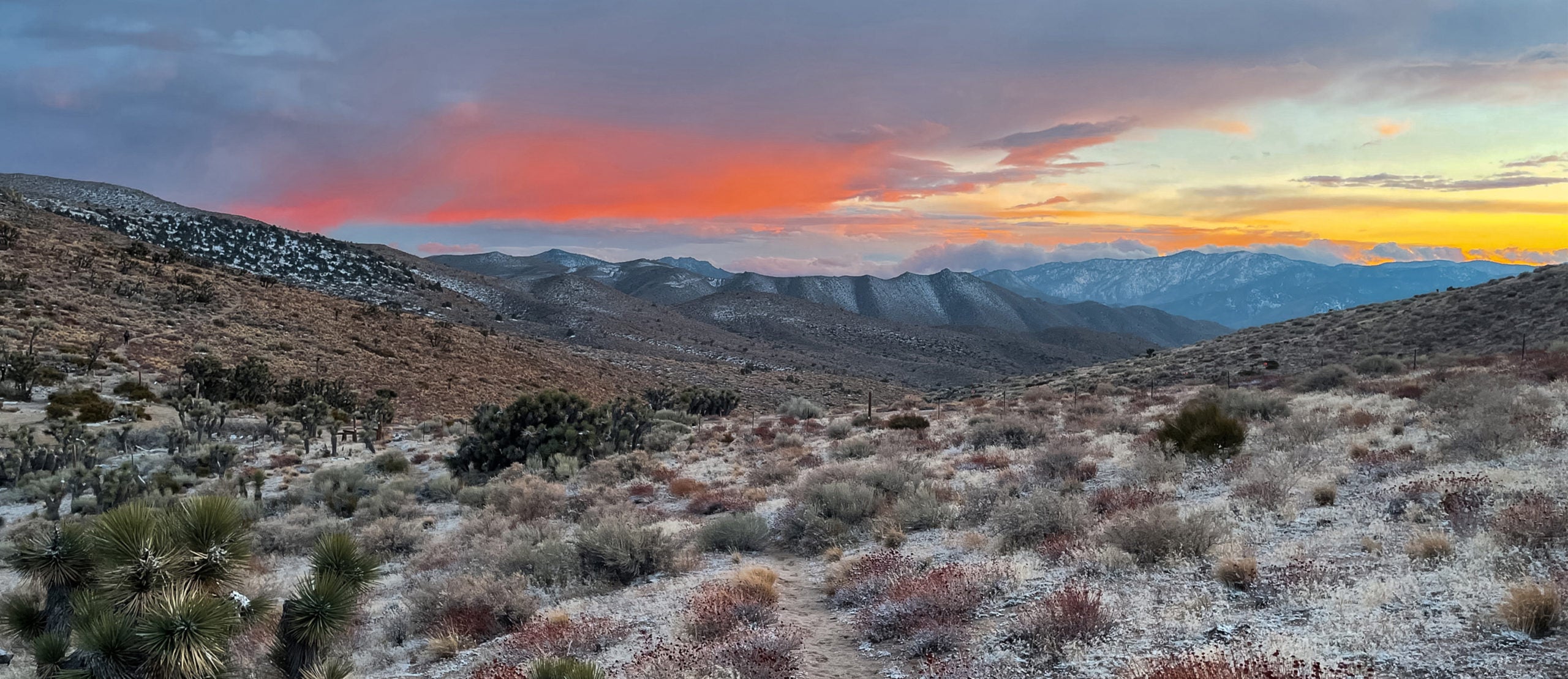Stanford classmates take on the Calendar Year Triple Crown
Sammy Potter and Jackson Parell, ’22, are attempting a feat only nine people are known to have accomplished: thru-hiking the Pacific Crest, Appalachian and Continental Divide trails in a single calendar year. Over the course of nearly 8,000 miles, they’ll climb the equivalent of Everest from sea level about 100 times and average a marathon every day.
Spring of 2020 was a dark season for Stanford student Sammy Potter, ’22. A best friend died; he got sick after early exposure to COVID-19; campus closed; he returned to his family home in Maine.

Sammy Potter, left, and Jackson Parell in Southern Virginia along the Appalachian Trail. (Image credit: Sammy Potter and Jackson Parell)
He was struggling to find purpose in the fog of the pandemic when he read about “Flyin’ Brian” Robinson, a computer engineer and speed hiker who, two decades earlier, had completed “the longest, fastest walk in American history”: all three major trails in the U.S. – the Pacific Crest, Continental Divide and Appalachian – in a single calendar year.
“Don’t ask what the world needs,” reads a quote Potter holds close to his heart. “Ask what makes you come alive and go do it.” In the Calendar Year Triple Crown, Potter saw the elements that would bring him to life.
He researched the idea for a few months and then pitched it to his close friend Jackson Parell, a housemate from Stanford, during a hike in the White Mountains of New Hampshire. Parell was quick to say yes.
Equal partners from that point on, Potter and Parell dedicated six months to meticulous preparation: training, planning resupplies, and securing sponsorships. New Year’s Eve found them in Georgia, at the southern terminus of the Appalachian Trail. They took their first steps at 6:55 a.m. on Jan. 1, 2021.
“There’s this scene in Forrest Gump where Forrest is dissatisfied with his circumstances and he decides to start running. And he runs across the country and then he runs back. And then he does that a few more times. I think that my reasons for being out here are largely similar to his: I was frustrated, dissatisfied. I needed time to figure myself out,” Parell says.
“When we actually started down the trail, I remember feeling an overwhelming sense of relief. We had spent so much time thinking about logistics; all there was left to do now was walk.”
On the trail
Thousands of people start thru-hiking the Appalachian Trail each year; only 1 in 4 finish. About a thousand attempt the Pacific Crest end-to-end. A couple hundred take on the Continental Divide. Nine are known to have succeeded in the Calendar Year Triple Crown – fewer people than have landed on the moon. None have been as young as Potter and Parell.
To date, the two have covered nearly 2,500 miles – nearly a third of the roughly 8,000-mile trek, which involves 2.66 million feet of elevation change and travel across 22 states. Over the course of their travel, they’ll climb the equivalent of Mount Everest in elevation about 100 times and average the distance of a marathon every day.
They’ve weathered a three-day stretch across a freezing landscape in New Mexico, which required crossing the Gila River 150 times. They survived their summit of Clingman’s Dome, the highest point on the East Coast, where freezing temperatures meant they went without water for the day and the combination of exhaustion, dehydration and cold brought on a hallucinatory sense of being pursued. They slept that night on the concrete floor of a public restroom.
Potter and Parell are chronicling their trip’s highs and lows on Instagram, @cytriplecrown.

Outside of Greenville, Tennessee, on the Appalachian Trail, Jan. 14. (Image credit: Sammy Potter and Jackson Parell)

Bakersville, North Carolina, on the Appalachian Trail, Jan. 17. (Image credit: Sammy Potter and Jackson Parell)
“Contrary to what some experts claim, in Southern California, the sun *doesn’t* always shine, and sometimes chakras *aren’t* aligned,” the pair wrote in an update from the Pacific Crest Trail at the end of March. “We battled some crazy weather and persistent injuries over the past couple weeks but we’re feeling great after finding some hot springs near Big Bear.”
Most recently, from the border of New Jersey and New York, where they’ve returned to complete the northern portion of the Appalachian Trail: “The more smooth and relatively short ups and downs on this section of the AT make it feel easy to get lulled into complacency … but that vibe is fleeting: The Green Mountains, White Mountains and the rocky (beautiful) armageddon/heaven that is the northern Maine outdoors are just around the corner. p.s. You would not believe the amount of restraint it is taking for us to not post pictures of our blisters.”
The most grueling hikes have often led to the most beautiful places, and the sensation itself is an end.
“Hardship, euphoria, even something as rough as loneliness – I just want to feel the things that come naturally as deeply as possible,” Potter says.
Back at Stanford
Whether or not they finish the Calendar Year Triple Crown (and they are determined to do it), the world, when they re-enter it, will be changed. A new administration is in office. Vaccines are widely available in the U.S. Campus is slowly coming back to life.
At Stanford, Potter and Parell will resume academic work that has centered on rural economic development and public policy, and they’re enthusiastic about assuming leadership roles in the outdoor community. They see their adventures as a critical complement to their scholarship.
“I know a lot of people that are frantic about making sure that every course, every extracurricular, every summer opportunity lines up perfectly to get them where they want to go at the end of their four years in college,” Parell says. “But no one is one-dimensional. Stanford has given me the freedom and the opportunity to explore other passions. And I know they’ll remain with me for the rest of my life.”
Potter has relished the sense of agency he’s gained on the trail, after being rendered so helpless in the early days of the pandemic.
“When you’re backed into a corner, it’s also an opportunity to do something you’re proud of,” he says. “For me, that’s taken the form of a new way of looking at life: taking actions that I can be proud of, not that are easiest; pursuing fulfillment over immediate happiness.”
“I don’t think at the end of this I’m going to feel satisfied. I want this to be the first in a lifetime of epic adventures.”
